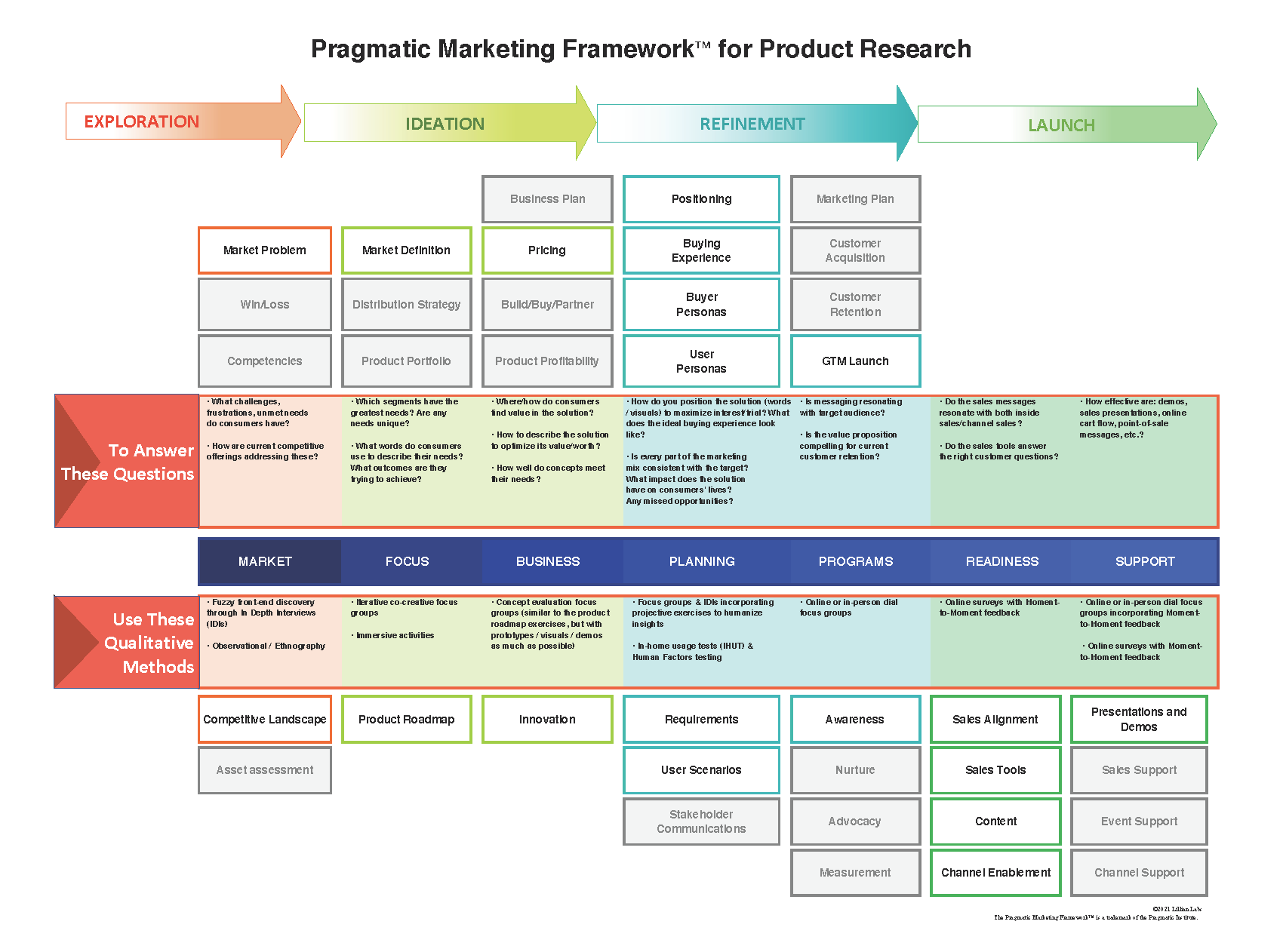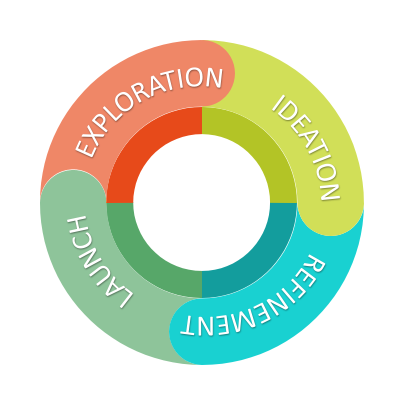Incorporating market research throughout all stages of new product development
Editor’s note: Gina Derickson is VP of research and consulting at Lillian Labs.
It’s easy for organizations to fall into the trap of siloing market research. But to fully realize the benefits of market research in new product development (NPD), it needs to span across teams and all respective stages of development.
A critical part of my job is to educate my clients (in this case, product marketing and management teams) on how market research can be used and where it can be used for maximum benefit.
To do so, it’s important to use familiar language and tools. So, I developed a riff on a tool familiar to product marketing and management teams, the pragmatic marketing framework. NPD teams use the framework to map out the essential activities needed to build and market products people want to buy. This version of the framework calls out the types of qualitative research we can use to inform and benefit every step of the way through the NPD process – from exploration through launch.
Keen observers will notice that throughout every stage of this new framework, consumers/customers are included in the key questions that need to be addressed. This is not by accident. It’s imperative for teams to stay engaged with their customers every step of the way and capture the true voice of the customer to inform every key decision point.
In my interactions with clients, most quickly grasp the value of market research to optimize concept development, from idea generation to development and testing/optimization, and into forecasting models (in the pragmatic marketing framework, this is the ideation and refinement stages). But what is often overlooked or undervalued is using market research during the exploration and launch portions of the process.
Using market research during exploration and launch
 During exploration, the goal is to identify the market problem by understanding the competitive landscape. Often, the focus is on the competition that is evident or visible, such as identifying key competitors in the marketplace, their offerings and outages. One might create a landscape analysis looking for white space that exists, focusing on the opportunity to create an offering to address this. These types of activities tend to bias solutions and only take into account products that already exist or technology looking for a need to fill. In many cases, this understanding doesn’t effectively represent consumers’ unmet needs, frustrations and challenges.
During exploration, the goal is to identify the market problem by understanding the competitive landscape. Often, the focus is on the competition that is evident or visible, such as identifying key competitors in the marketplace, their offerings and outages. One might create a landscape analysis looking for white space that exists, focusing on the opportunity to create an offering to address this. These types of activities tend to bias solutions and only take into account products that already exist or technology looking for a need to fill. In many cases, this understanding doesn’t effectively represent consumers’ unmet needs, frustrations and challenges.
A better approach to this stage is to have a diverging mind-set, one that is open to possibilities that may not yet exist or needs consumers may have a hard time articulating or visualizing potential solutions for. For example, 20 years ago, it would have been impossible for consumers to express the need for an iPhone because they’d never seen or heard of one and couldn’t fathom the concept of a product that could meet their needs in that way. If a seed of an idea isn’t discovered during exploration it will never have a chance to mature into a concept to be developed later in the framework, resulting in missed opportunities.
Launch is another area where the consumer voice may not be fully articulated. Even the best concept can suffer if its sales and advertising efforts fail to efficiently drive customers through the trial and repurchase cycles. Missing the mark at this stage not only potentially wastes valuable sales and channel resources, it can also kill a viable new product, allowing competitors to better position a similar product and introduce it to the market more effectively.
Incorporating qualitative research throughout new product development
You’ve educated your business partners and they are on board. What’s next? Here are three suggestions leveraging potential targets for actionable insights that will inform and inspire the NPD road map.
- During exploration, create a research plan that includes discovery research with an observational component. Include an in-context element to qualitative research, such as in-depth interviews in consumers’ homes or in stores with them, wherever they use or make decisions about the products they use. Debrief not only on what they said, but also what you saw or what they said that didn’t make sense based on what you observed.
- For launch, test materials in a manner that most closely represents the way consumers will interact with the information. For a direct sales approach, mock up an interaction or record a video of a consumer interaction and get feedback on it. Techniques such as eye-tracking, facial coding and dial testing help get beyond the surface-level reaction to stimuli and provide a more emotional understanding of what works and doesn’t work well.
- Any time you incorporate qualitative research into your NPD process, develop a robust plan by leveraging a different style of thinking. Some of my favorite ideas include a love letter exercise from a consumer to a brand you’re interested in, or a dyad interview where two consumers with a relationship (friends, spouses, etc.) are interviewed together to understand how they really interact with a given category. These techniques not only develop richer insights, but they also increase the level of client engagement, which ultimately maximizes market research spend.
The more we educate our internal and external clients on how market research can be used and where it can be included to maximize its benefits, the more success stories we’ll compose.
